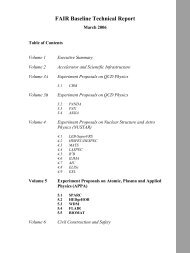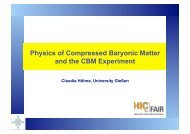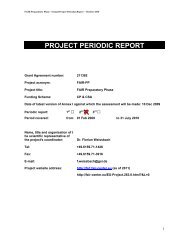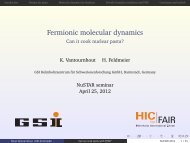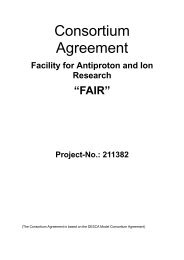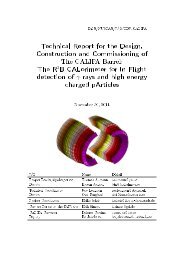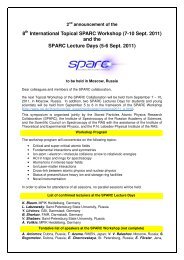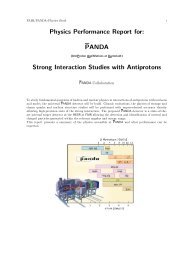NeuLAND - FAIR
NeuLAND - FAIR
NeuLAND - FAIR
You also want an ePaper? Increase the reach of your titles
YUMPU automatically turns print PDFs into web optimized ePapers that Google loves.
counts<br />
70<br />
60<br />
50<br />
40<br />
30<br />
20<br />
10<br />
0<br />
15 15.5 16 16.5 17<br />
time (ns)<br />
Figure 3.2.: The measured time difference as shown in the left part of figure 3.1, but<br />
with a condition on central hits in order to exclude position dependencies.<br />
time difference spectrum of bar S1 and S2 of 186 ps, thus a time resolution of σt=132 ps<br />
for each bar, with a condition on central hits. We interpret this increase of about 50%<br />
for the time resolution to be similar shared in between the two modifications, i.e. the<br />
increase in length, causing a loss of light, and the read-out with the more economical<br />
photomultiplier. The effect of the bar length was studied independently in experiments<br />
with single-electron beams, see section 3.3. We observe about 25% degradation, when<br />
going from 2 to 3 m length.<br />
3.3. Studies with 31 MeV Electrons<br />
Detailed studies of the detector response of the scintillator bars were performed using the<br />
single-electron per bunch mode of the superconducting electron linac ELBE at HZDR<br />
Dresden-Rossendorf. The electrons had an energy of 31 MeV. For the time reference<br />
determination a similar technique as for the tests of resistive-plate chambers at ELBE<br />
was applied, see appendix B for details. The energy loss of these minimum ionizing<br />
particles (MIPs) is slightly less compared to the 500 MeV proton beams (see section 3.2).<br />
In this experiment the two bars of sizes 200×3×3 cm 3 and 200×5×5 cm 3 were exposed<br />
to the beam individually. As light readout we selected again the 1 inch photomultiplier<br />
R8619, as in the second part of the proton tests. The time resolution was measured<br />
versus the radio-frequency signal from the accelerator, which delivers a very precise<br />
timing information. Together with the resolution of our readout electronics TacQuila,<br />
the time resolution of this reference signal amounted to σref =30 ps, see figure 3.3.<br />
From the measurement with the 2 m long bars we derive a time resolution of σ200×3×3 =154 ps<br />
31





